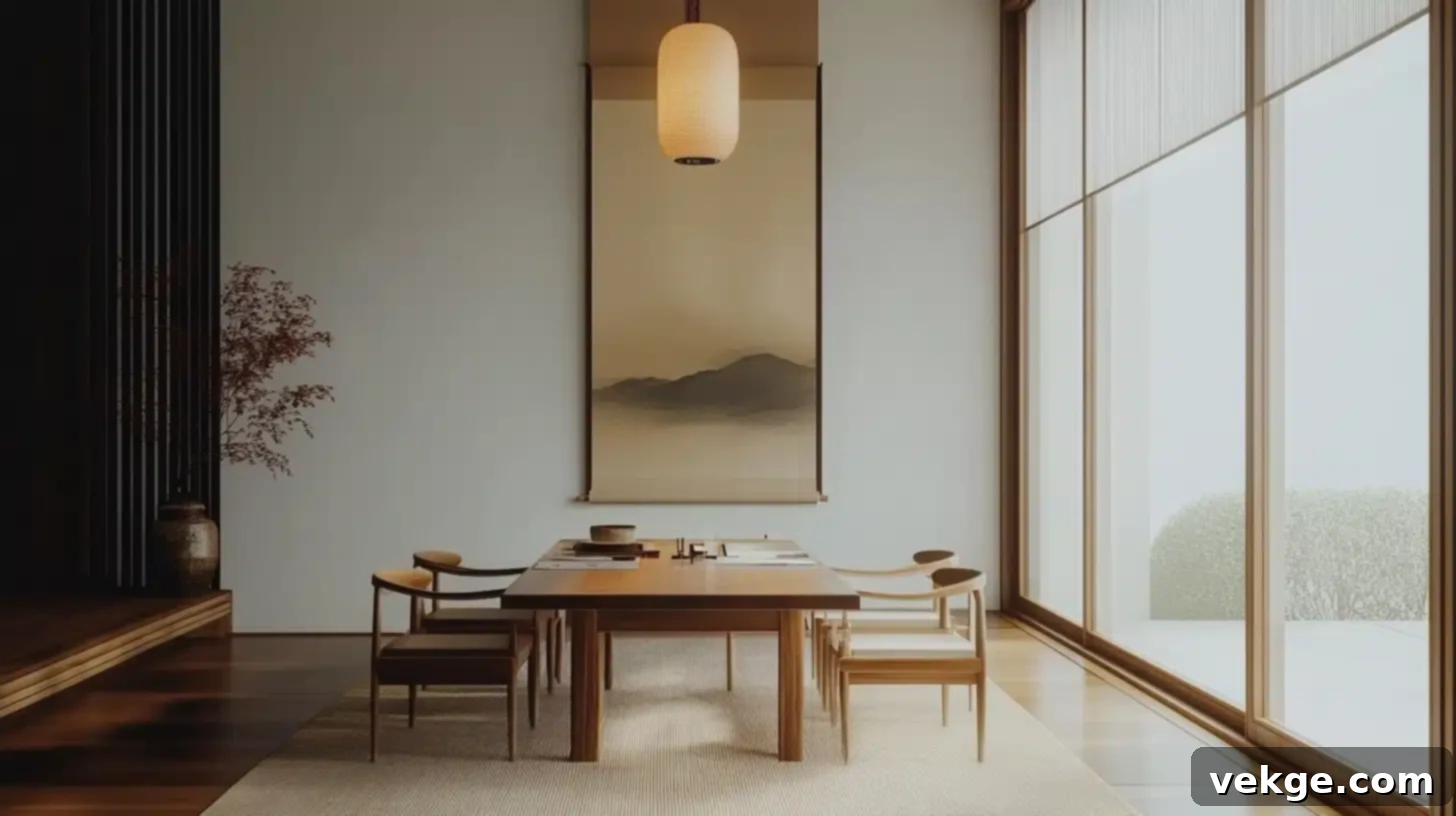Harmonious Living: Your Ultimate Guide to Japandi Dining Room Design
The dining room is more than just a place to eat; it’s the heart of your home where cherished memories are made, stories are shared, and daily routines unfold. It plays a pivotal role in setting a calm and welcoming tone for your entire living space. If you’re seeking a design aesthetic that perfectly balances beauty with practical functionality, the Japandi style offers an ideal solution for your dining area.
Japandi is a modern interior design trend that gracefully merges the understated elegance of Japanese aesthetics with the warm minimalism of Scandinavian decor. This unique fusion captures the best elements of both worlds, resulting in a dining room that feels both invitingly cozy and refreshingly uncluttered. It’s a design philosophy perfectly suited for contemporary living, offering a peaceful retreat from the demands of busy daily life.
This comprehensive guide will walk you through every step of creating your dream Japandi dining room. We’ll delve into essential aspects, from selecting the perfect color palette and incorporating natural textures to choosing furniture that embodies this sophisticated Japanese-Scandinavian blend. Whether you’re embarking on a complete renovation or simply wish to infuse your existing dining space with subtle Japandi influences, you’ll find all the inspiration and practical advice you need right here.
What is Japandi Style?
At its core, Japandi design is a celebration of simplicity, functionality, and natural beauty. It’s a thoughtful blend of two distinct yet complementary design philosophies: Japanese minimalism (often linked to Wabi-sabi, which embraces imperfection and transience) and Scandinavian functionality (known for its focus on comfort, practicality, and light, often associated with Hygge). The result is an aesthetic that prioritizes serenity, order, and an appreciation for craftsmanship.
In a Japandi dining room, you’ll encounter a harmonious environment defined by clean lines, soft and muted color schemes, and an abundant use of natural materials. This fusion creates spaces that feel open, airy, and profoundly peaceful. Imagine a dining table crafted from smooth, light-colored wood, complemented by comfortable chairs with elegant, uncluttered forms, and subtle touches of greenery. Japandi style maintains a streamlined look without ever feeling sterile or stark; instead, each carefully selected piece serves a purpose, contributing to a sense of balance and maximizing the potential of every inch of your space.
Key Features of a Japandi Dining Room
Bright and Airy: Maximizing Natural Light
Japandi dining rooms excel at harnessing natural light. Large windows, glass doors, or even strategically placed mirrors can significantly brighten the space and forge a strong connection with the outdoors. The goal is to create an open and luminous atmosphere. For artificial lighting, the focus remains on simplicity and warmth. Think of sleek, sculptural pendant lights with diffused glow, or elegant table lamps that provide ambient light without drawing excessive attention. These fixtures enhance the room’s serene mood rather than dominating it.
Nature-Inspired: Embracing Organic Materials
Natural materials are paramount in Japandi design, bringing an organic warmth and tactile richness to the space. Wood is undeniably the star, often seen in dining tables and chairs crafted from sustainable timbers like oak, ash, walnut, or even bamboo. These materials not only add visual beauty but also provide a comforting, earthy foundation. Beyond wood, other natural elements such as rattan, jute, linen, cotton, and stone play significant roles. These materials introduce varying textures and a sense of grounding, making the dining room feel more connected to nature and profoundly peaceful.
Tactile Appeal: A Symphony of Textures
While the overall Japandi aesthetic champions smooth surfaces and clean lines, it masterfully incorporates diverse textures to add depth and interest. This thoughtful layering prevents the space from feeling flat or monotonous. You might find the striking contrast of a rough, hand-thrown ceramic bowl resting on a polished wooden table, or a soft, organic linen tablecloth draped over a minimalist dining surface. Upholstered chairs might feature subtly textured fabrics, or woven placemats could complement sleek dinnerware. These contrasts are key to creating a dining room that is not only visually appealing but also incredibly cozy and inviting to touch.
Why Choose Japandi for Your Dining Room?
A Japandi-inspired dining room offers much more than just a beautiful aesthetic; it provides a holistic approach to living that enhances well-being and simplifies daily life. Here are compelling reasons why this style might be the perfect fit for your home:
- Cultivates Peace and Quiet: Japandi style excels at creating a truly calm and tranquil atmosphere. Imagine gathering for meals in a space that inherently encourages relaxation, allowing you to shed the day’s stresses and focus on meaningful connections.
- Effortless Tidiness: With its emphasis on minimalism and purposeful design, a Japandi dining area naturally promotes order. Smart, integrated storage solutions and fewer, high-quality items mean your space remains neat and organized with minimal effort, contributing to a sense of calm.
- Timeless Appeal: By focusing on classic lines, natural materials, and a muted palette, Japandi design transcends fleeting trends. It’s a style that will remain elegant and relevant for years to come, representing a wise investment in your home’s aesthetic.
- Sustainable Choice: The preference for natural, durable, and often locally sourced materials aligns perfectly with sustainable living practices. Choosing quality over quantity and appreciating the longevity of items contributes to a more eco-conscious home.
- Versatile and Adaptable: While distinct, Japandi’s core principles of simplicity and natural elements make it highly adaptable. It can seamlessly integrate with existing design elements or serve as a foundational style that allows for subtle personal touches over time.
How to Incorporate Elements of Japandi Design into Your Living Space
While our primary focus is the dining room, the principles of Japandi design are universally applicable throughout your home, including your living areas. This beautiful fusion of Japanese minimalism and Scandinavian functionality offers a serene and elegant aesthetic for any space. By blending these two styles, you can create an environment that is both calming and inviting, with a consistent focus on simplicity, natural materials, and purposeful design.
Choose a Neutral and Muted Color Palette
The foundation of any Japandi space, including your dining room or living area, is a carefully chosen color palette. This typically involves muted, natural tones that create a sense of calm and openness.
- Base Colors: Opt for soft whites, warm beiges, and light grays for larger surfaces like walls, ceilings, and significant furniture pieces. These colors serve as a clean backdrop, allowing other elements to subtly shine.
- Accent Hues: Introduce warmth and gentle contrast with muted earth tones such as terracotta, dusty greens, deep charcoals, or soft blues. These can be incorporated through textiles, pottery, or decorative objects, adding depth without overpowering the serene atmosphere.
Focus on Textures and Layers
Texture is vital in Japandi design, adding warmth and interest to an otherwise minimalist scheme. It’s how the space gains its cozy and inviting character.
- Layered Textiles: Mix and match different textures through throws, cushions, and rugs. Think chunky knits, soft linens, raw cotton, or subtle wool weaves. Patterns should be minimal and organic, if present at all.
- Natural Fibers: Prioritize natural fibers like wool, jute, sisal, and bamboo in your rugs, baskets, and decorative items. These materials not only add warmth and visual appeal but also enhance the connection to nature, a cornerstone of Japandi style.
13 Best Japandi Dining Room Ideas
1. Organic Shapes in Dining Room
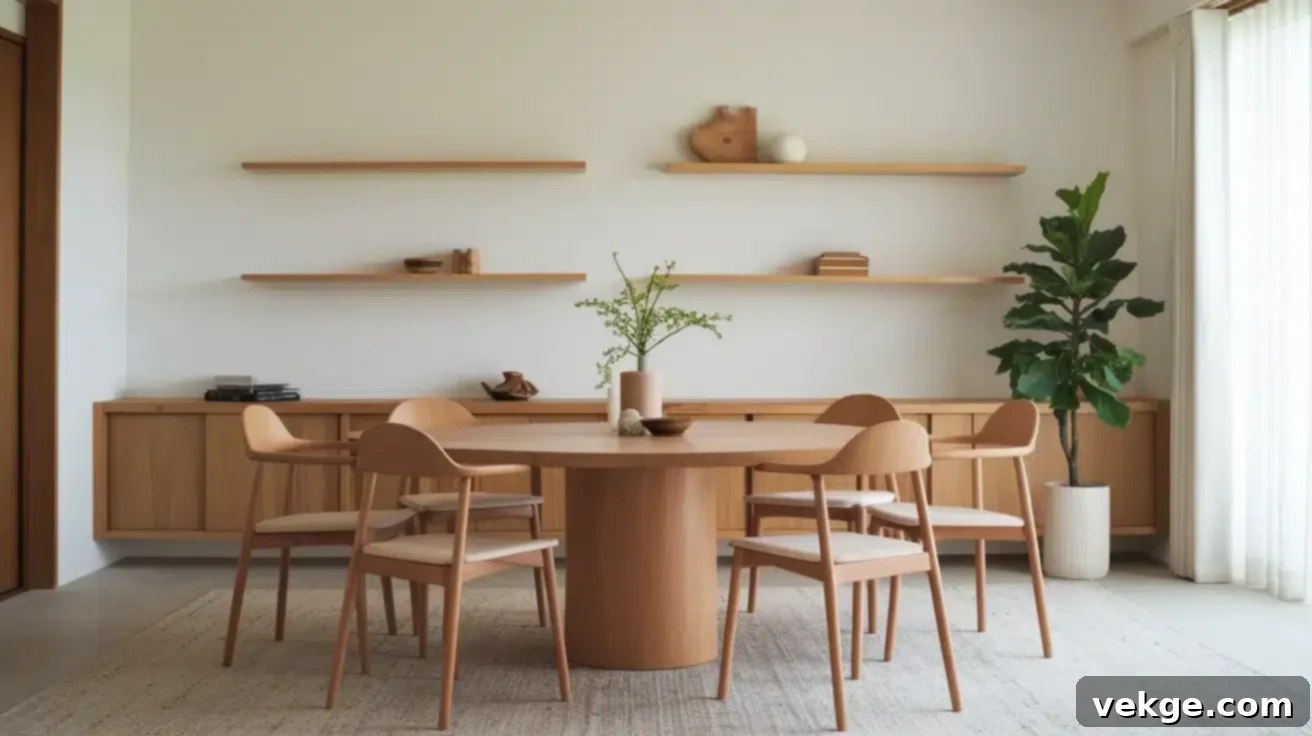
Infuse your dining space with furniture and decor that feature soft, natural curves. This could manifest as an elegant round or oval dining table, chairs with gently sculpted backs, or even gracefully arced light fixtures. Organic shapes introduce a sense of fluidity and softness, providing a comforting contrast to the often straight lines found in minimalist aesthetics. They create a more relaxed, inviting atmosphere, encouraging conversation and comfort.
2. Statement Artwork

Select a single, impactful piece of art that truly embodies the essence of Japandi style. This could be a large painting or print characterized by simple lines, abstract forms, or serene nature-inspired themes. The key is to choose artwork that utilizes negative space effectively, mirroring the uncluttered, contemplative feel of Japandi design. A minimalist landscape, a subtle calligraphic piece, or an abstract shape in muted tones can serve as a powerful focal point without overwhelming the calm of the room.
3. Slanted Ceiling
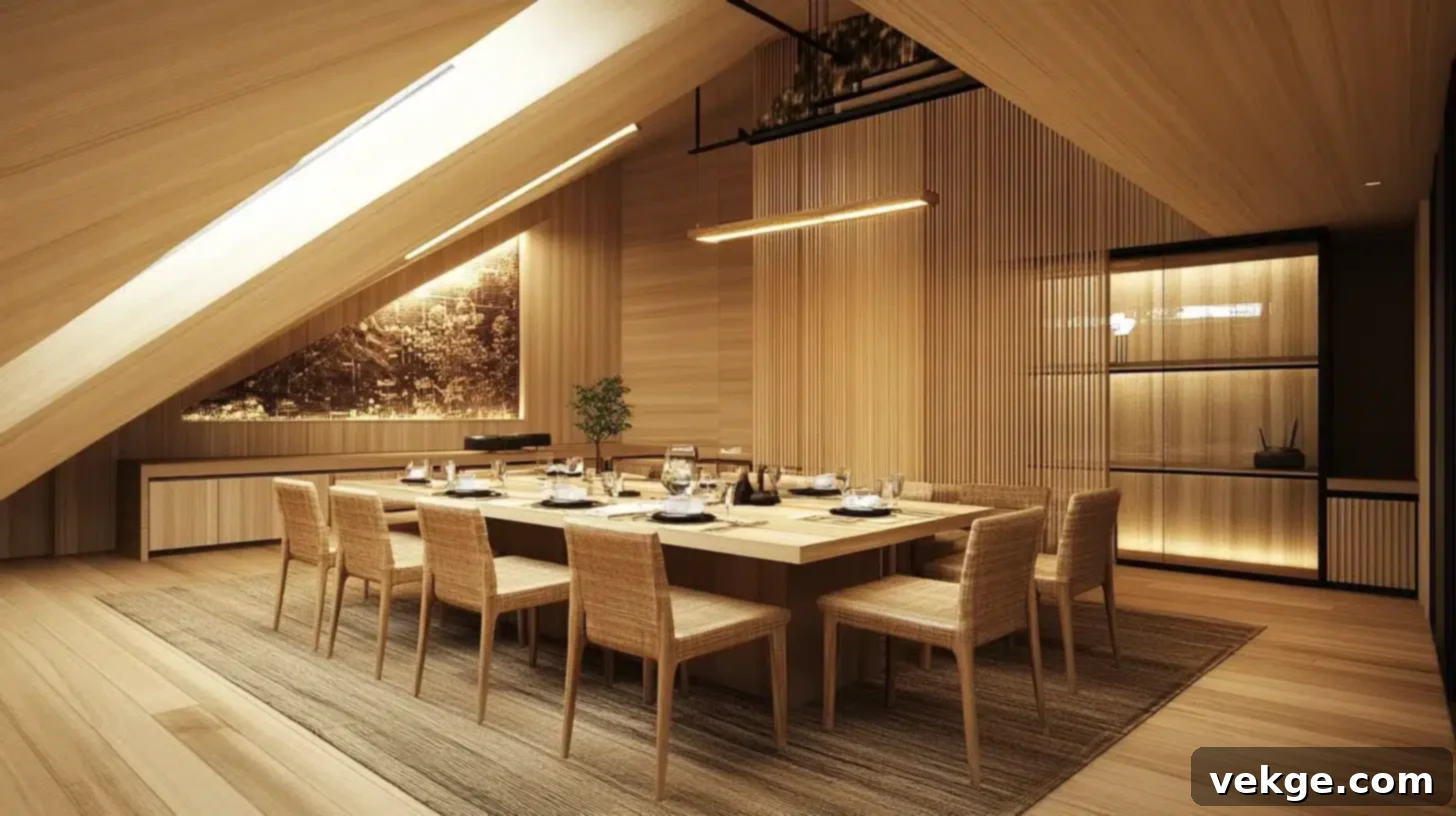
If your home features or allows for it, incorporating a slanted ceiling can dramatically enhance your Japandi dining room. This architectural feature adds significant visual interest and creates a wonderful sense of openness and airiness, making even smaller spaces feel more expansive. To amplify this effect and reinforce the Japandi aesthetic, consider cladding the slanted portion with light-colored wood paneling, which will further elevate the feeling of height and natural warmth.
4. Wood Slat Walls
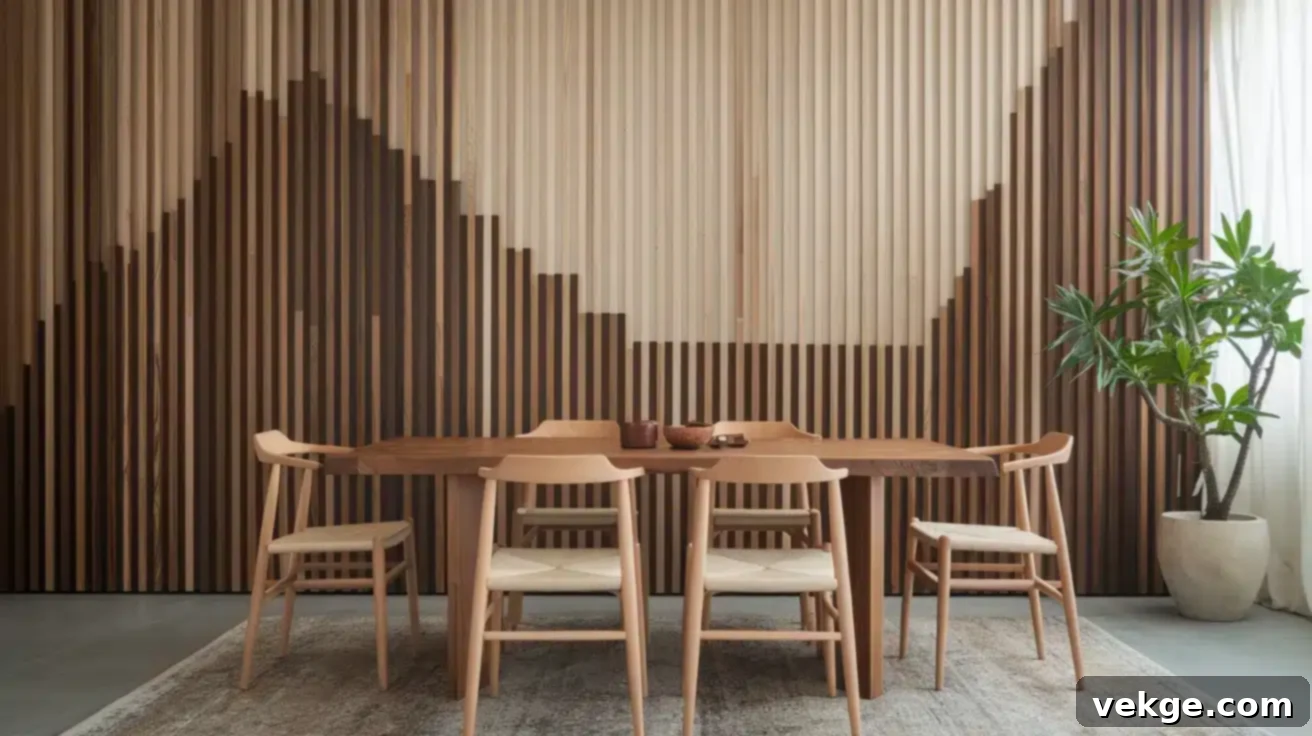
Install a wood slat wall as a stunning backdrop to your dining area. This design element instantly adds a rich layer of texture and warmth, while simultaneously maintaining the clean, structured look synonymous with Japandi. You can experiment with different wood tones within the slats – perhaps a mix of light and slightly darker hues – to create a subtle yet captivating pattern, adding remarkable depth to the wall without it becoming visually overpowering. Beyond aesthetics, slat walls can also provide acoustic benefits.
5. Warm Color Palette with Globe Lantern Lighting
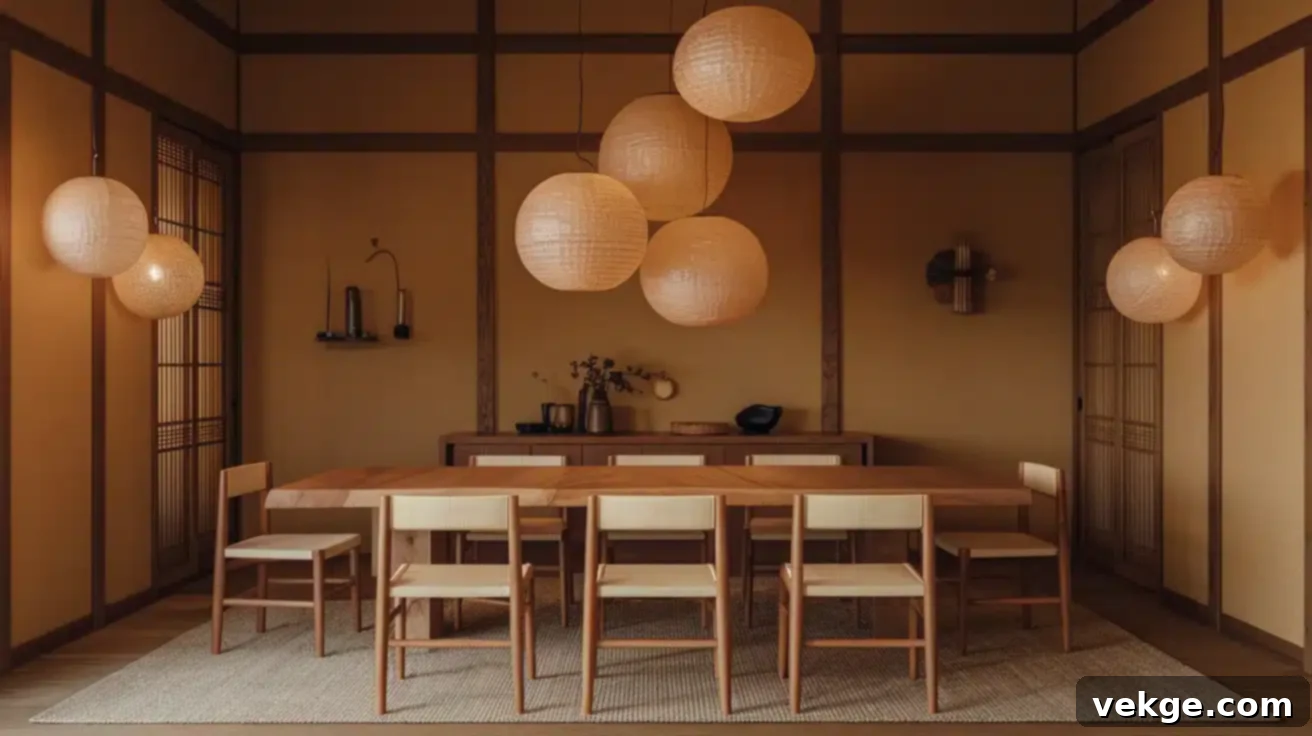
Design your dining room around a palette of warm, earthy tones for walls, furniture, and textiles. Think soft terracottas, muted ochres, gentle sands, and warm grays. Complement this inviting color scheme with the soft, diffused glow of globe lantern lighting. Choose lanterns made from natural materials like paper, frosted glass, or textured fabric to cast a gentle, ambient light and create interesting shadows, enveloping the room in a soothing, cozy atmosphere perfect for evening meals.
6. Sliding Shoji Screens
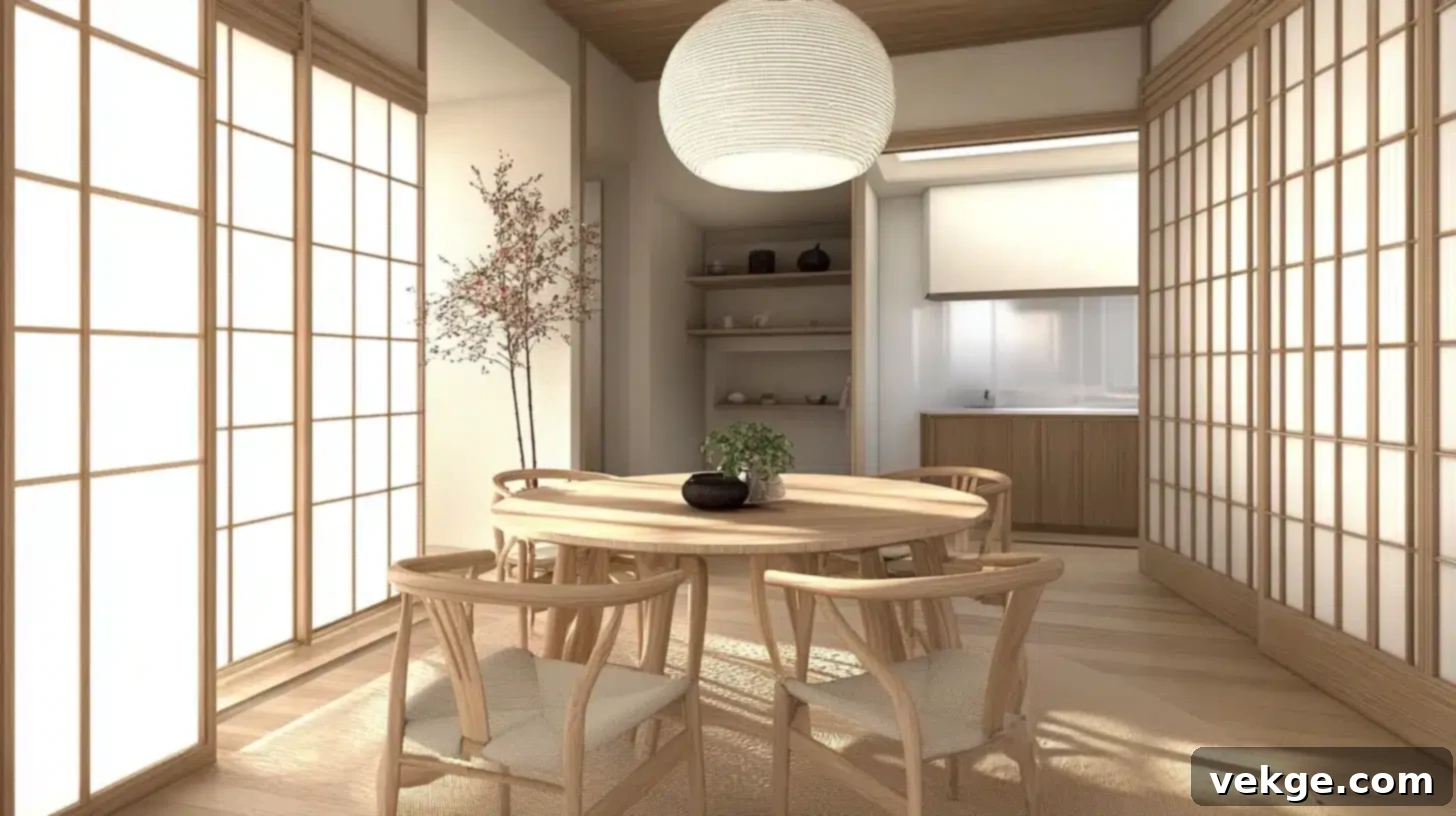
Introduce an authentic Japanese element with sliding shoji screens. These lightweight, translucent screens can serve multiple purposes: dividing larger open-plan spaces, providing privacy, or acting as a beautiful decorative feature. They diffuse natural light beautifully, creating a soft, ethereal glow. For an added touch of interest, select screens that feature abstract or nature-inspired patterns subtly etched into the paper, enhancing their visual appeal while maintaining their delicate aesthetic.
7. Using Bamboo in the Furniture
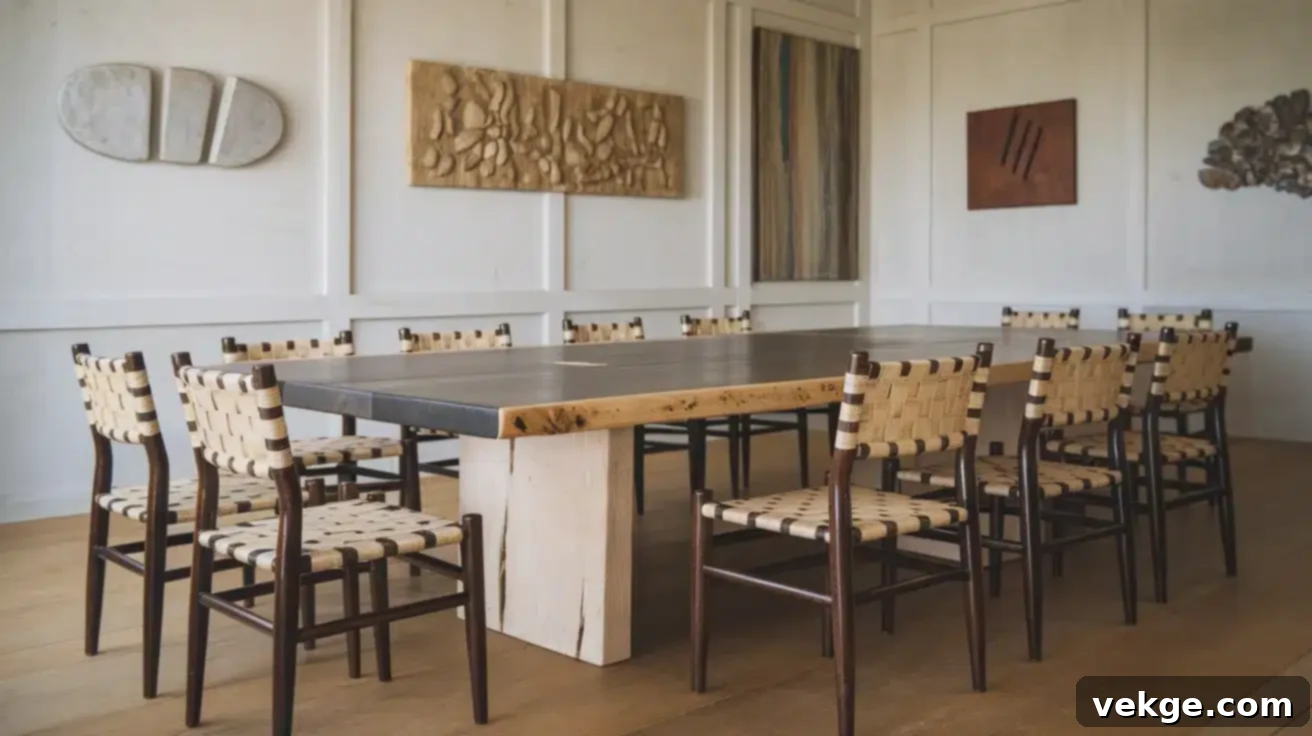
Integrate bamboo elements into your dining furniture to highlight its natural beauty and sustainable qualities. This could include sleek bamboo chair legs, sturdy table bases, or even subtle accents on sideboards. Bamboo is not only strong and eco-friendly but also visually appealing, offering a unique texture and a light, airy feel. Seek out bamboo pieces that proudly display the natural variations in the material’s color and texture, celebrating its organic imperfections.
8. Adding Floor Cushions
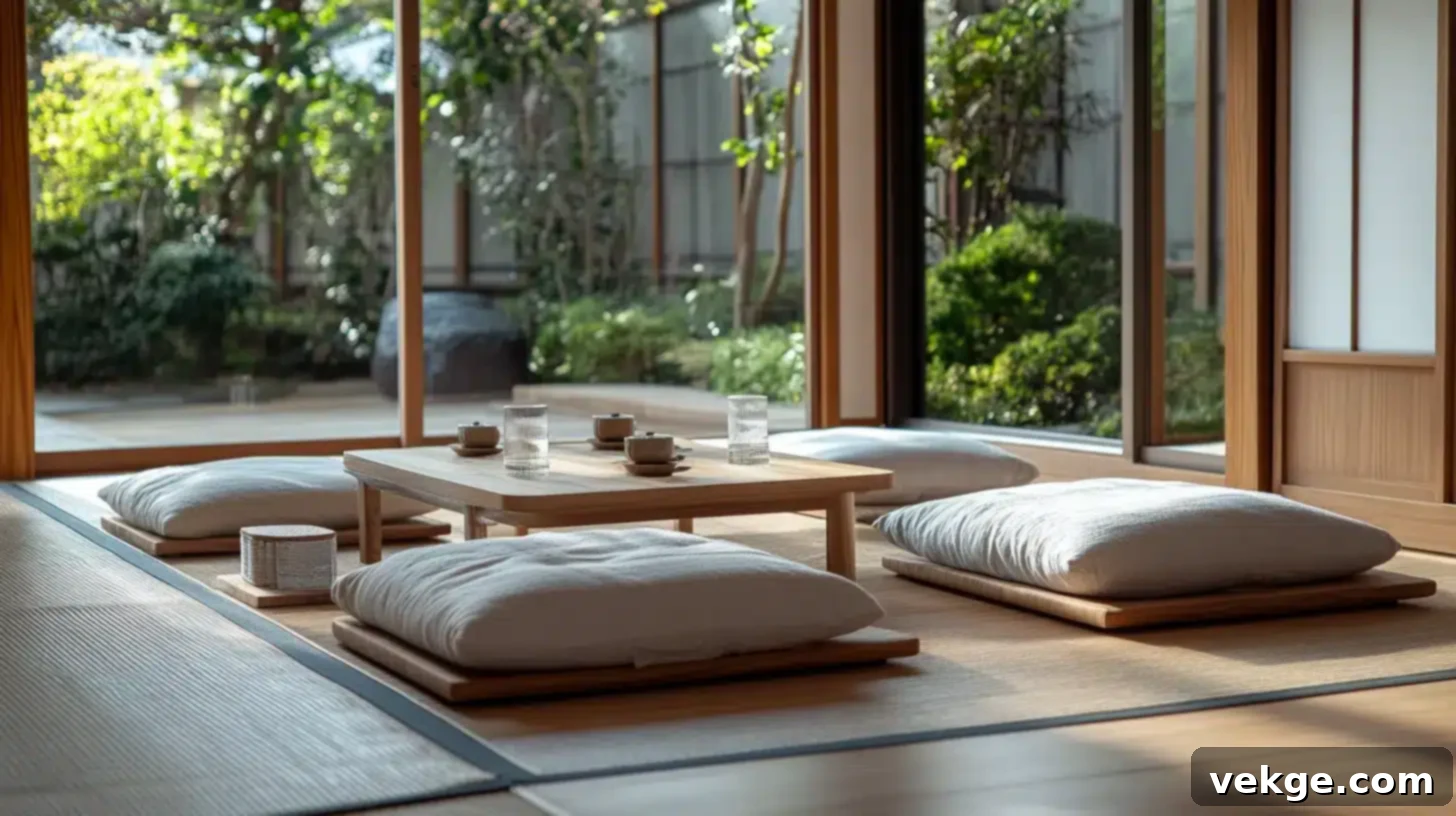
Introduce a sense of informal comfort and flexibility by placing floor cushions near your dining area, particularly if you have a low-profile table. This pays homage to traditional Japanese dining customs while offering adaptable seating for larger gatherings or casual lounging. For a truly cohesive Japandi blend, choose cushions upholstered in natural fabrics with subtle geometric patterns or solid colors, drawing inspiration from Scandinavian textile designs. They add texture and an inviting softness.
9. Open Shelving
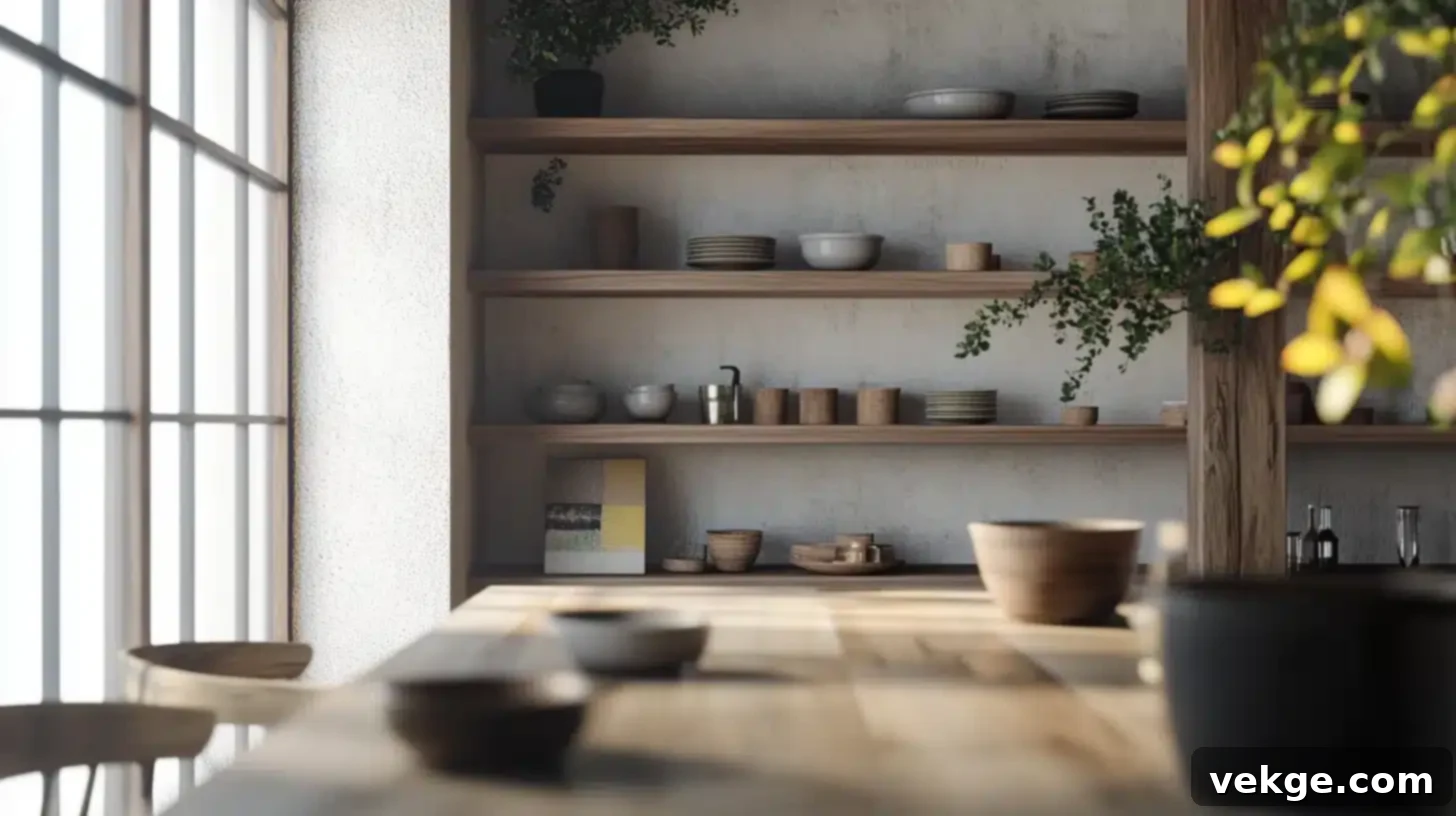
Install open shelves in your dining room to thoughtfully display a carefully curated selection of items. This approach keeps the space feeling open and airy, while still allowing for personal expression and decorative touches. Display minimalist pottery, elegant glassware, a few beloved books, or small plants. To maintain the Japandi aesthetic of clean lines and understated elegance, opt for shelves with hidden brackets, creating a sleek, floating look that aligns perfectly with the style’s emphasis on simplicity and functionality.
10. Tatami Mats

Incorporate traditional Japanese tatami mats into areas adjacent to or defining your dining space. These unique floor coverings, made from woven rush grass, introduce a distinctive texture, a natural aroma, and an immediate sense of calm and tradition. They can help delineate different zones within an open-plan living area or create a serene reading nook. Consider creating a slightly raised tatami platform near your dining table for a subtle multi-level effect, adding depth and defining the space with cultural authenticity.
11. Earthy Tones
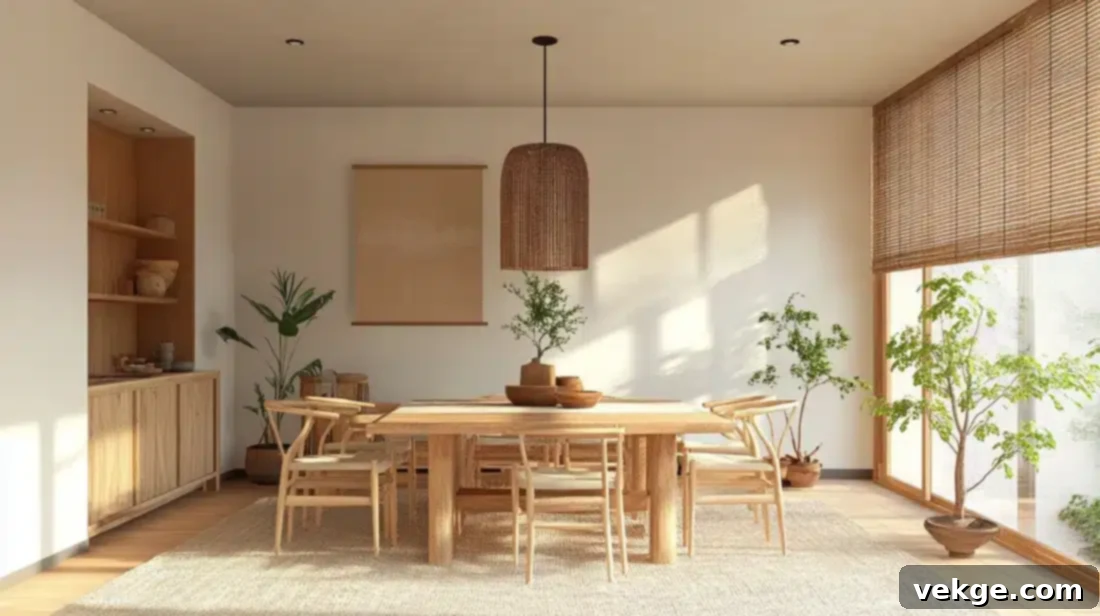
Anchor your dining room in a soothing palette of earthy colors. Embrace hues inspired by nature, such as soft clay, warm sand, muted stone grays, and deep forest greens. This grounding color scheme permeates the space with a tranquil and serene atmosphere, fostering relaxation and connection. Integrate these tones not just through paint but also through natural materials like unglazed ceramics, textured linen textiles, and stoneware, adding layers of depth and authenticity to your Japandi design.
12. Adding Handcrafted Elements
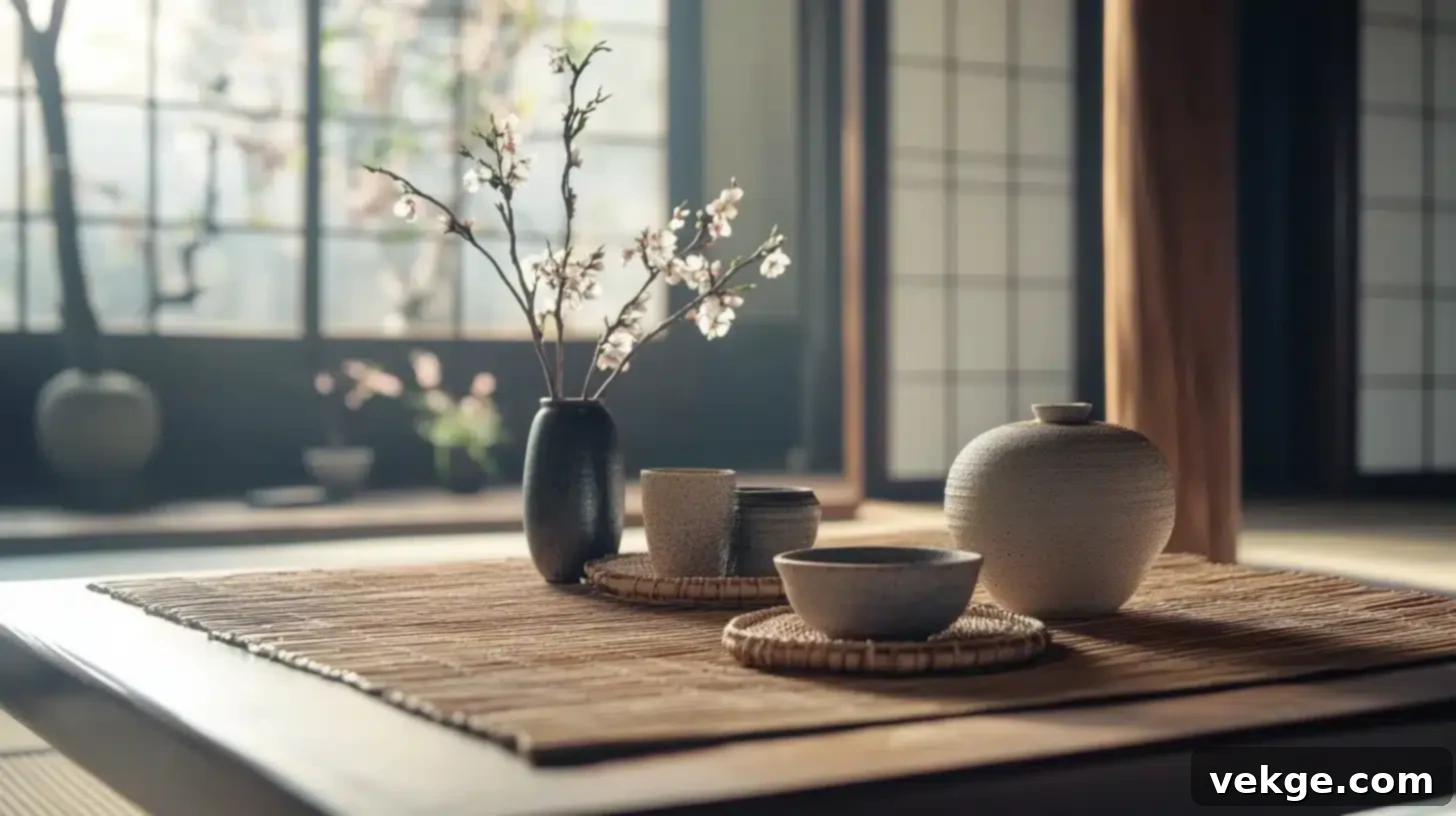
Enrich your dining room with pieces that celebrate human touch and exquisite craftsmanship. Include items such as hand-thrown pottery, exquisitely hand-woven baskets, artisanal wooden bowls, or bespoke textiles. These handcrafted elements add unique character, warmth, and a story to your space, moving away from mass-produced uniformity. Embrace the Japanese concept of Wabi-sabi by choosing items that might bear slight imperfections or show the natural aging process, celebrating their unique beauty and authenticity.
13. Japanese Calligraphy Art
Hang a piece of Japanese calligraphy as a focal point or a subtle decorative accent. This elegant art form introduces a profound cultural touch and can serve as a thoughtful conversation starter. Calligraphy, with its clean lines and powerful strokes, aligns perfectly with Japandi’s minimalist ethos. To beautifully weave the Japandi theme together, select calligraphy that represents concepts valued in both Japanese and Scandinavian cultures, such as “harmony,” “simplicity,” “peace,” or “flow,” deepening its meaning and relevance within your space.
Japandi Dining Room Furniture Recommendations
Dining Tables
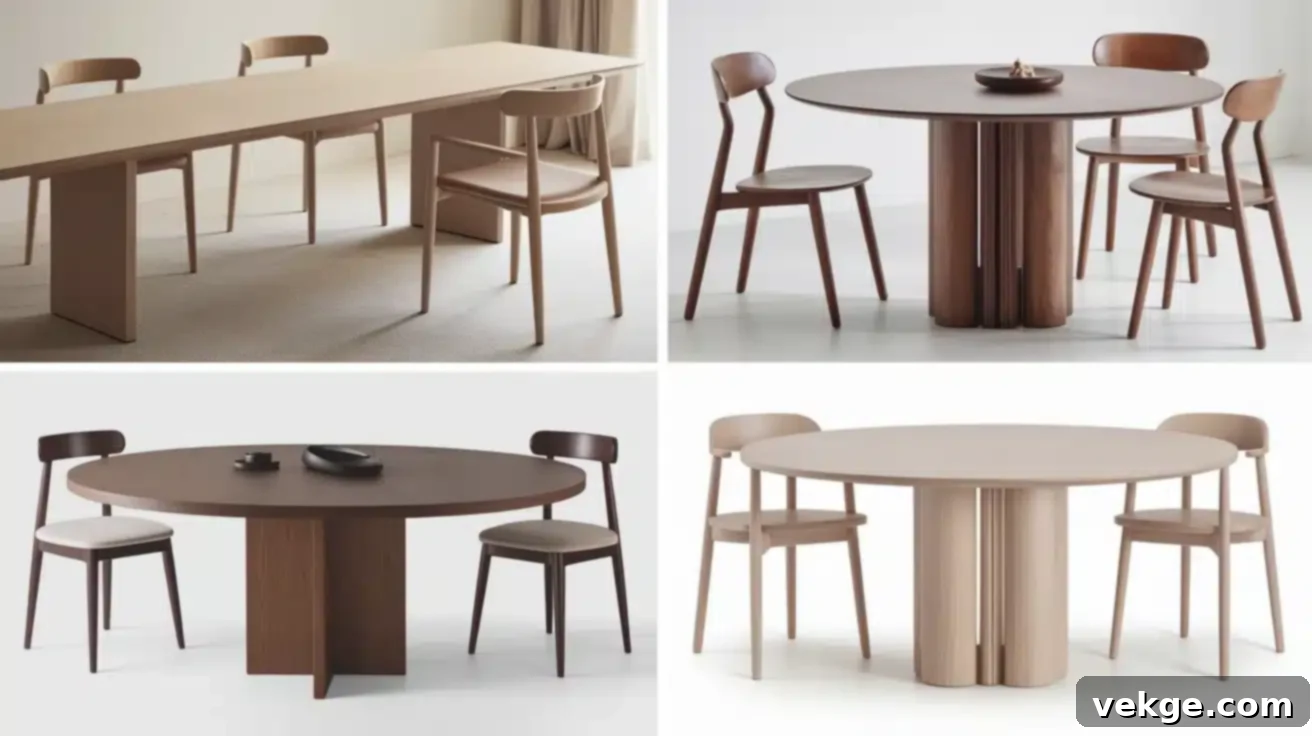
| Design Features | Styles |
|---|---|
| Simple, minimalist design with a focus on natural elegance. Crafted from high-quality, sustainable natural woods like light oak, warm ash, or rich walnut. Characterized by clean lines, smooth surfaces, and robust construction. Absolutely free of ornate or excessive decorative details, embracing pure form. |
Rectangular or Oval Tables: Offering ample functionality and generous seating with a sleek, unobtrusive appearance. Round Tables: Encouraging conversation and intimacy with their soft, communal shape. Low-profile Tables: Inspired by traditional Japanese dining, these provide a unique, authentic experience when paired with floor cushions or minimalist seating. |
Dining Chairs
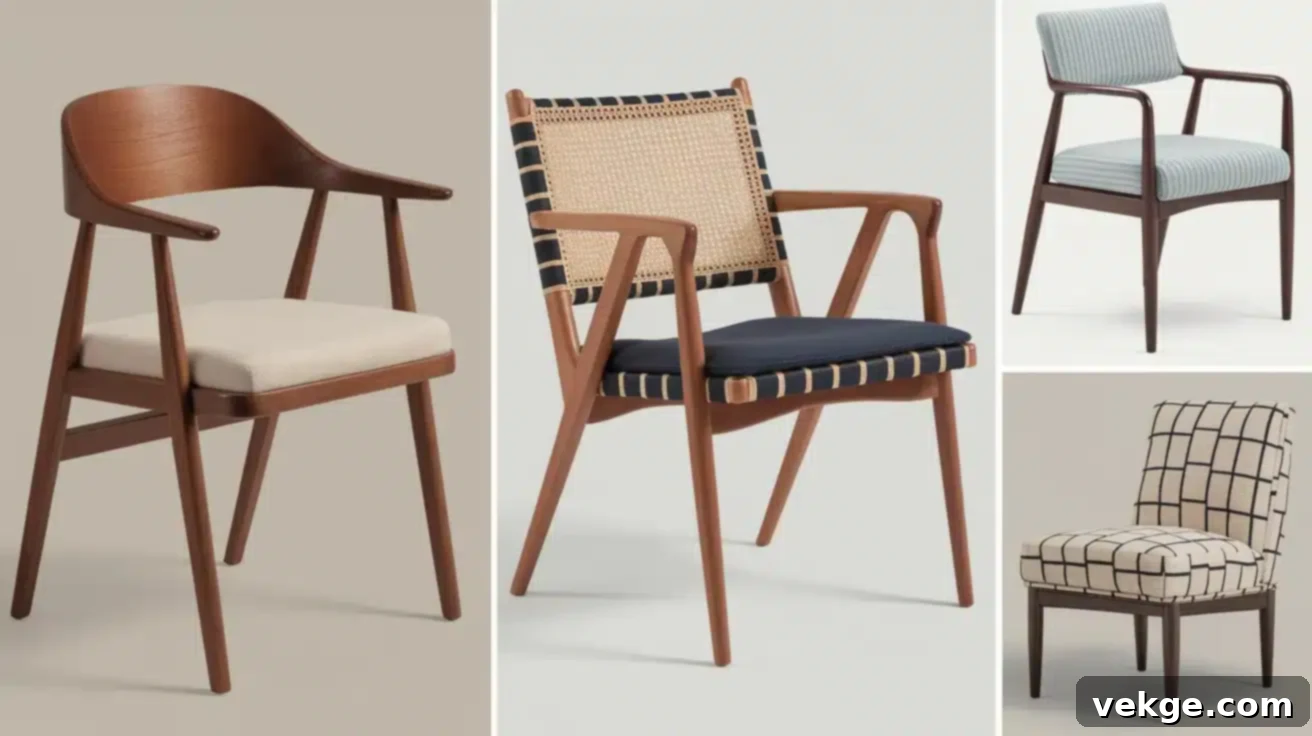
| Design Features | Styles |
|---|---|
| Minimalist silhouettes that prioritize ergonomic comfort and visual lightness. Engineered for long-lasting comfort, inviting guests to linger. Constructed from natural wood materials, often matching or complementing the dining table. Upholstery, if present, features neutral-toned fabrics (linen, cotton, wool) for subtle texture and warmth. |
Classic Wooden Chairs: Simple, elegant, and devoid of excessive embellishments, letting the material speak for itself. Bench Seating: A sturdy wooden bench can enhance a communal dining feel, offering flexible seating. Upholstered Seats: Chairs with subtle fabric cushions or woven seats add an extra layer of comfort and tactile appeal without compromising the minimalist aesthetic. Rattan or Woven Chairs: Introducing natural texture and an airy, organic feel. |
Storage and Sideboards
| Design Features | Styles |
|---|---|
| Characterized by flat fronts and sleek, understated profiles. Features minimal or hidden hardware to maintain an uncluttered and seamless look. Designed to offer essential storage while contributing to an overall sense of order and serenity. |
Natural Wood Sideboards: Choose a sideboard in a light or dark wood tone that harmonizes beautifully with your dining table and chairs, offering discreet storage for dinnerware. Open Shelving: Floating shelves can be used to display a carefully curated selection of minimalist decor pieces, ceramics, or frequently used dinnerware, keeping essentials accessible. Integrated Cabinetry: Custom-built, flush cabinetry can provide seamless storage, blending into the wall for an ultimate minimalist effect. |
Where to Find Japandi Dining Room Furniture
Finding the perfect Japandi furniture involves seeking out retailers that prioritize quality craftsmanship, natural materials, and minimalist designs. Here are some excellent starting points:
1. Specialty Stores
- Muji: A Japanese brand renowned for its minimalist, functional designs and high-quality, natural materials. Muji offers furniture, storage solutions, and accessories that seamlessly fit the Japandi aesthetic, emphasizing simplicity and utility.
- IKEA: While a global giant, IKEA’s extensive range of Scandinavian-style furniture, particularly pieces with clean lines and natural wood finishes, can be adapted to complement Japandi design principles effectively and affordably. Look for their solid wood ranges.
- HAY: A Danish design company known for its modern, minimalist furniture, lighting, and accessories. HAY offers pieces with clean lines, high-quality materials, and a contemporary edge that aligns well with the refined side of Japandi.
- Ethnicraft: Specializes in solid wooden furniture, emphasizing quality, durability, and timeless design. Their pieces often feature simple, robust forms and beautiful wood grains, making them excellent candidates for a Japandi dining room.
2. Online Retailers
- West Elm: Offers a wide selection of modern furniture made from natural and reclaimed materials. Their clean-lined dining tables, chairs, and storage options often lean towards a minimalist and earthy aesthetic, suitable for Japandi.
- Etsy: A fantastic platform to discover handcrafted, unique pieces from independent artisans worldwide. You can find bespoke wooden furniture, ceramic dinnerware, woven textiles, and art that embody the unique, handcrafted aspect of Japandi.
- Wayfair: With an enormous inventory, Wayfair requires careful filtering. Use keywords like “minimalist dining table,” “natural wood chairs,” “Scandinavian modern,” or “Japanese style” to narrow down options that fit the Japandi criteria.
- Article: Known for its direct-to-consumer model, offering stylish, modern furniture often featuring solid wood and clean designs at competitive prices, many of which are perfect for a Japandi home.
Conclusion
As we’ve journeyed through this guide, it’s clear that creating a Japandi dining room is far more than just adhering to a set of design rules; it’s about curating a space that deeply resonates with both the heart and the mind. It’s an artful blend where the profound warmth of Japanese aesthetics meets the practical, comfortable functionality of Scandinavian design, culminating in an environment that truly nurtures well-being.
Every element we’ve discussed, from the gentle embrace of organic shapes and the ergonomic comfort of curved chairs to the integral use of natural materials like sustainable wood and bamboo, contributes to a harmonious and balanced whole. The deliberately chosen muted color palettes, the thoughtful and diffused lighting choices, and the careful integration of handcrafted items all converge to create a dining area that is not only visually appealing but also profoundly comfortable, inherently practical, and endlessly inviting.
Ultimately, the enduring success of Japandi design lies in its inherent balance. It challenges us to find that perfect sweet spot between the elegant simplicity of minimalism and the cozy comfort of thoughtful living, bridging the gap between ancient tradition and modern functionality. By embracing these principles, you can transform your dining room into a tranquil haven where every meal becomes a moment of calm, connection, and conscious living.
FAQ (Frequently Asked Questions)
What is the Difference Between Wabi-Sabi and Japandi?
Wabi-sabi is a deeply philosophical Japanese concept that celebrates the beauty of imperfection, transience, and the natural cycle of growth and decay. It values authenticity, naturalness, and finding beauty in the unassuming and aged. Japandi, on the other hand, is a modern interior design style that ingeniously combines Japanese aesthetics (which often include elements of wabi-sabi) with Scandinavian minimalism and functionality. While wabi-sabi principles can certainly inform and enrich a Japandi space, Japandi itself encompasses a broader spectrum of design elements, including Scandinavian comfort, practicality, and light, clean lines.
Are There Cost-Effective Ways to Achieve a Japandi Look?
Absolutely! Achieving a beautiful Japandi look doesn’t require a large budget. Start by using neutral paint colors for your walls, which are generally affordable and create a perfect backdrop. Incorporate natural elements found in nature, such as branches, smooth stones, or simple potted plants. Choose simple, clean-lined furniture, and consider repurposing existing pieces by painting them or updating hardware. Add texture with affordable textiles like linen throws, cotton cushion covers, or jute rugs. DIY art with minimalist designs or simple abstract patterns can also save money while personalizing your space. Focus on decluttering and creating open space – that’s free!
What are the Core Principles of Japandi Style?
The core principles of Japandi style revolve around creating a harmonious, functional, and serene environment. These include:
- Simplicity and Functionality: Prioritizing useful, well-designed items and avoiding clutter. Every piece should have a purpose.
- Neutral Color Palette: Using a base of muted, earthy tones (whites, grays, beiges) with subtle natural accents.
- Natural Materials: Extensive use of wood (light and dark), bamboo, rattan, stone, linen, cotton, and ceramics.
- Embrace Negative Space: Allowing breathing room around objects and furniture to create a sense of calm and openness.
- Minimal Decor: Thoughtfully curating a few, high-quality decorative items rather than many.
- Quality Over Quantity: Investing in durable, well-crafted pieces that will last.
- Nature-Inspired Touches: Bringing the outdoors in with plants and natural light.
- Handcrafted Elements: Incorporating artisanal pieces that celebrate craftsmanship and uniqueness.
- Subtle Contrasts: Blending smooth and rough textures, light and dark woods to add interest without disruption.
